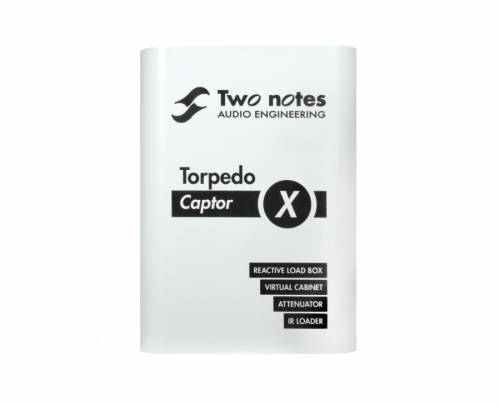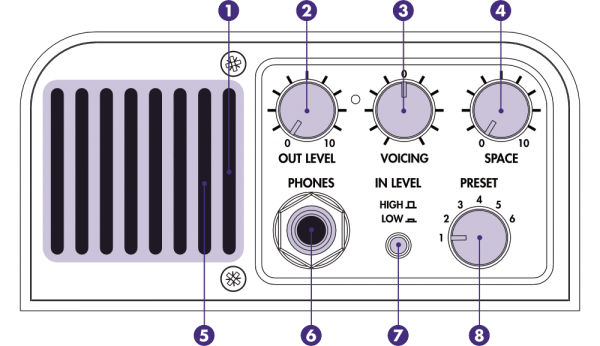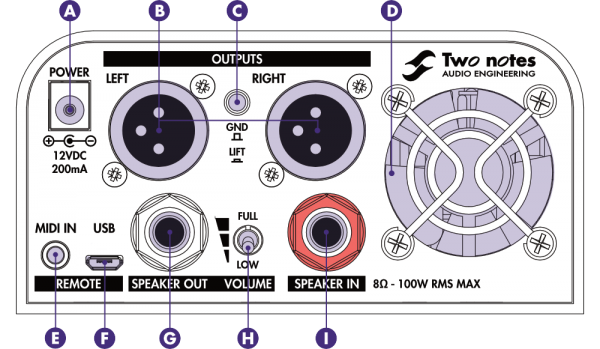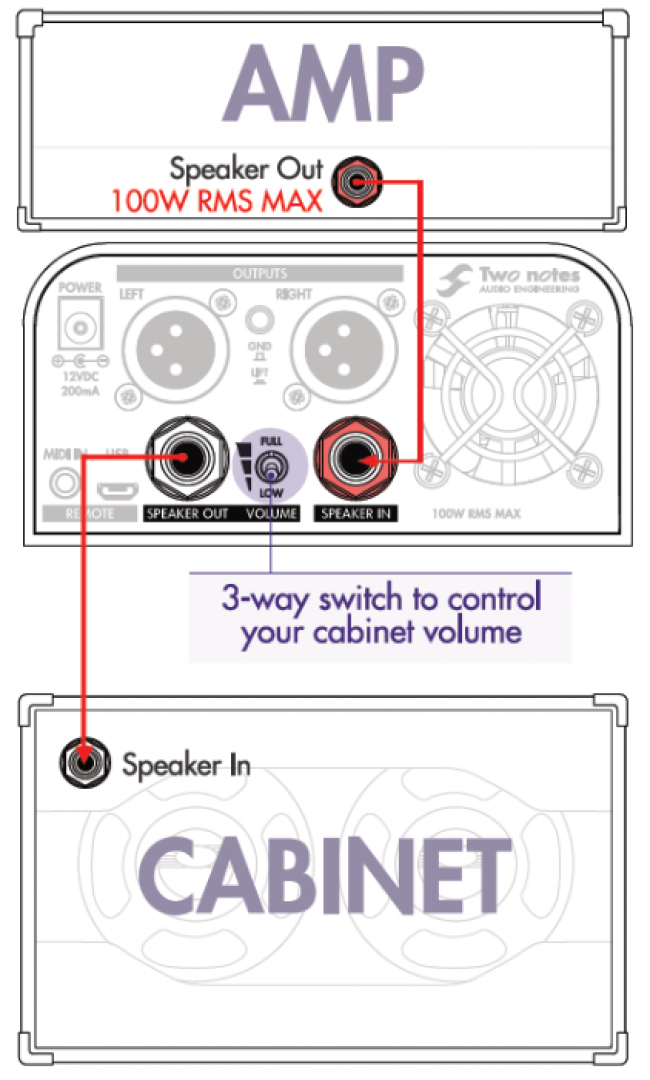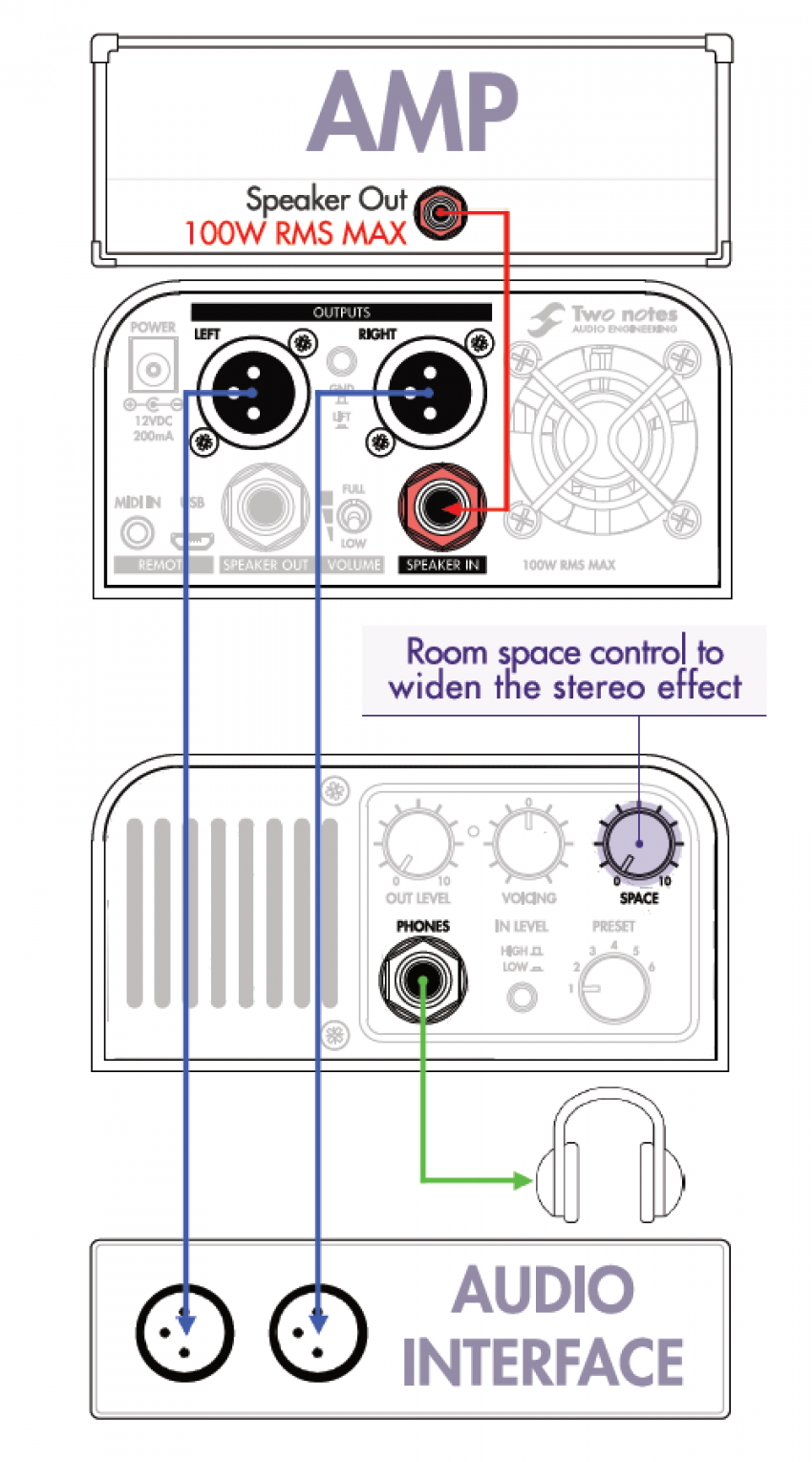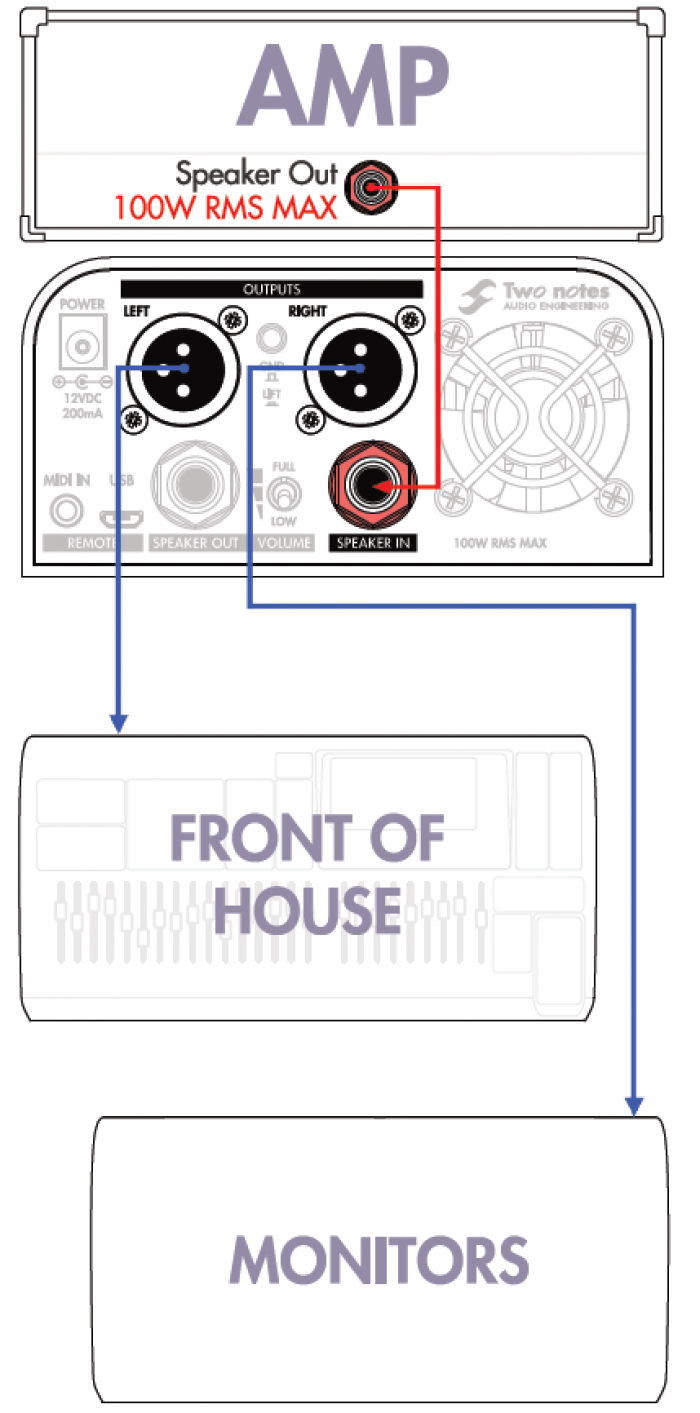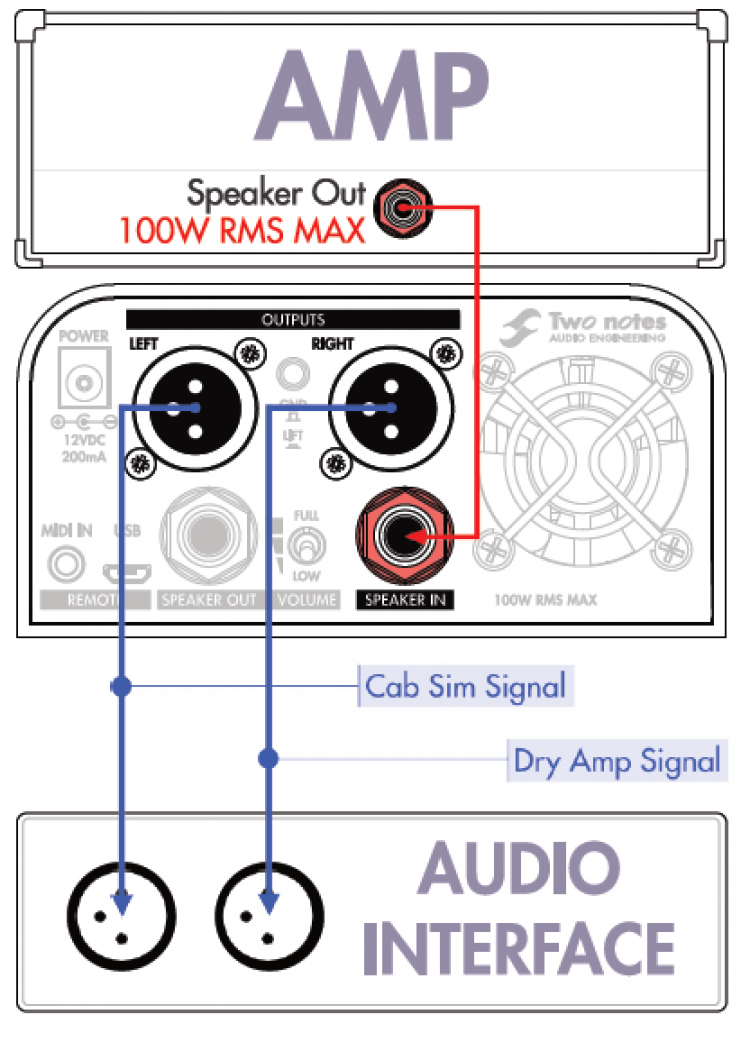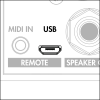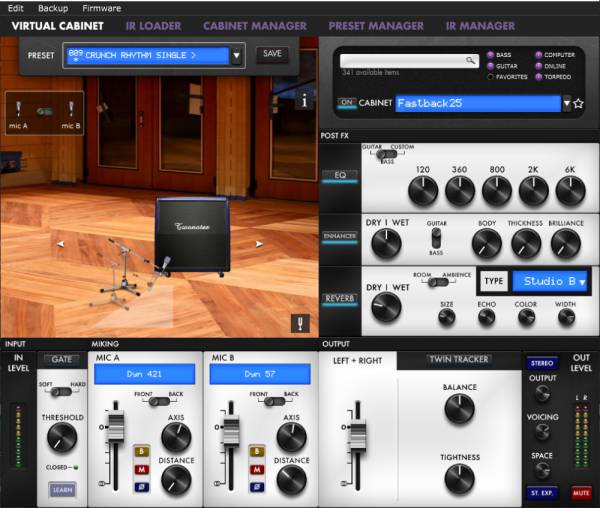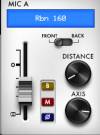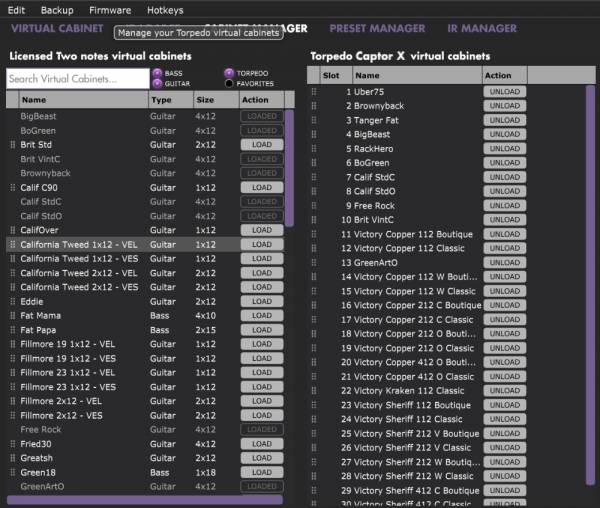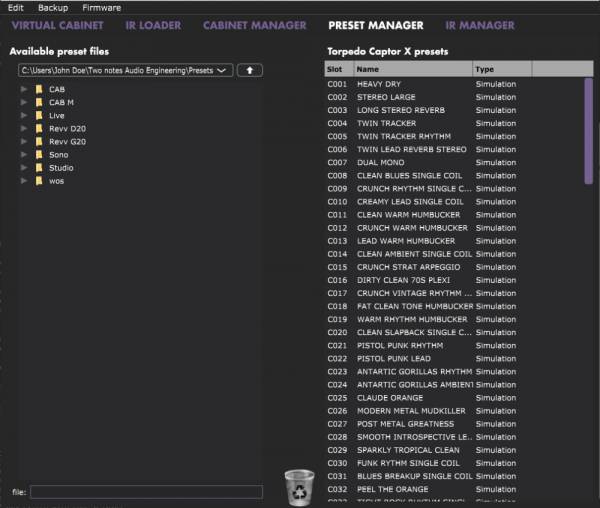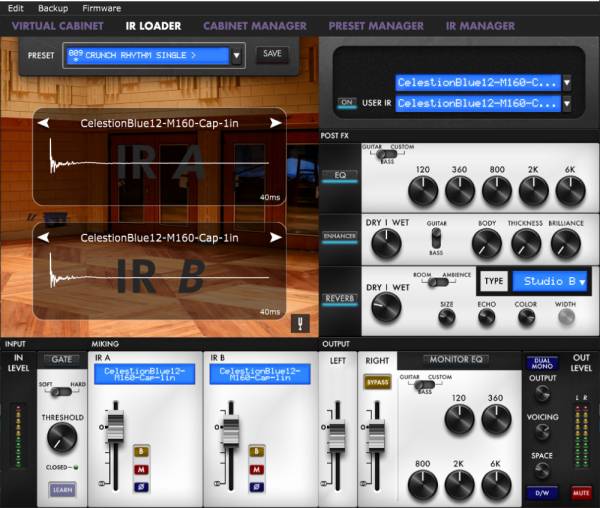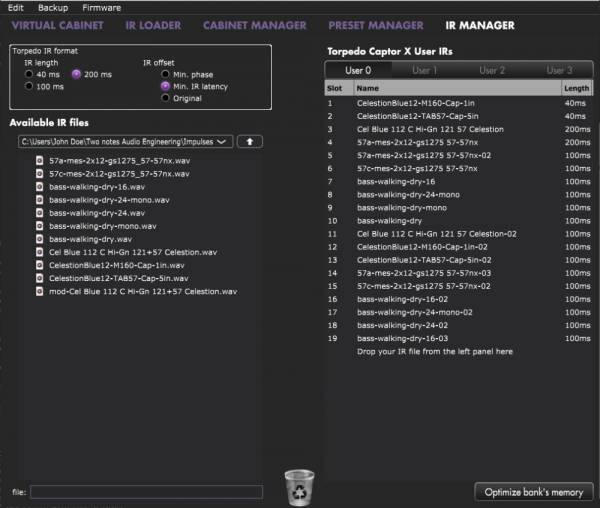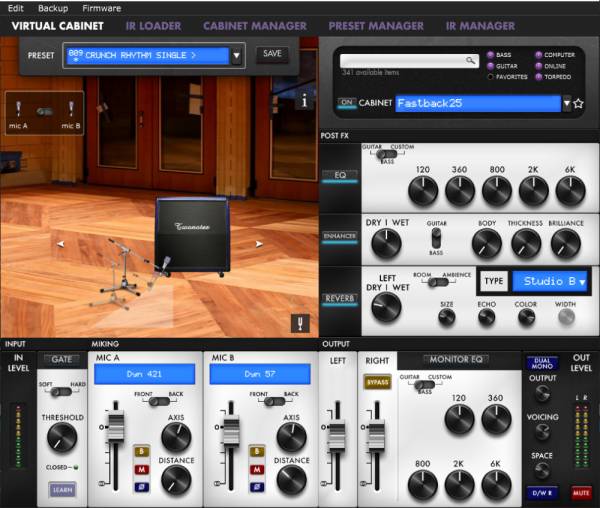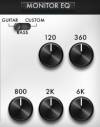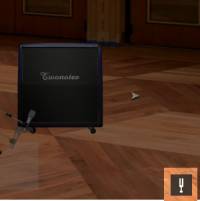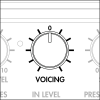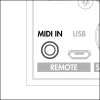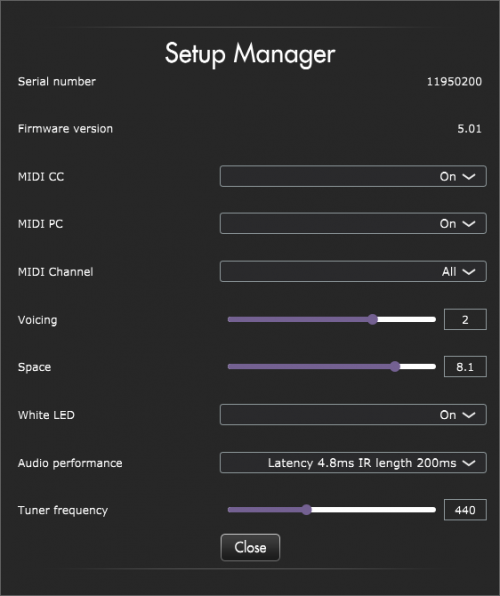- en
- fr
Torpedo Captor X User's Manual
Compact reactive load box, tube amp attenuator, miked cab simulator, IR loader and stereo expander
The complete electronic version of this manual, as well as the Two notes Audio Engineering software and hardware products, are subject to updates. You can download the most recent versions of the products on the Two notes Audio Engineering website.
This manual describes the Torpedo Captor X and provides instructions for its operation. It is highly recommended that you read this document before using the product. The contents of this manual have been thoroughly verified and it is believed to accurately describe the product at the time of shipment from the factory or downloaded from our website.
Two notes Audio Engineering is a registered trademark of:
OROSYS SAS
76 rue de la Mine
34980 Saint-Gély-du-Fesc
France
Tel: +33 (0)484 250 910
Fax: +33 (0)467 595 703
Contact and support: http://support.two-notes.com
Website: http://www.two-notes.com
This document is the exclusive property of OROSYS SAS. In the interest of product development, OROSYS SAS reserves the right to change technical specifications, modify and/or cease production without prior notice. OROSYS SAS cannot be held responsible for any damage, accidental or otherwise, that results from an inappropriate use of the Torpedo Captor X Please refer to the safety instructions included in this manual. The reproduction of any part of this document is strictly forbidden without the written authorization of OROSYS SAS.
All product names and trademarks are the property of their respective owners. Product names and trademarks found in this document were used during the development of the Torpedo Captor X product but are in no way associated or affiliated with OROSYS SAS.
Foreword
1. Safety instructions
Before using the product, it is necessary to carefully read and to bear in mind the following information. Keep this document in a safe place as it is important for the protection of both user and product. Should you suspect any malfunction of the device, always seek the assistance of a qualified technician.
1.1 Reader warning
1.2 Power adapter
Please verify that the voltage required by the mains power adapter matches the voltage in your country. If not or if unsure, do not connect the unit to the wall outlet. This could result in damage to the mains power adapter, the unit and injuries to the user. This product must not be used when there is lightning. In case of severe weather with a risk of lightning, unplug the power adapter to reduce the risk of electric shock and fire.
The mains power adapter provided with the machine complies with the standards of the country where you purchased the product. If replacement is needed, please use a standard compliant mains power adapter.
1.3 Safety use conditions
The Torpedo Captor X must never be used near a heat source, near a flame, in the rain, in damp areas, near any kinds of liquids. When transporting the unit, care needs to be taken to avoid any shocks that could cause damage that would require the assistance of a qualified technician. Exposure to moisture is basically a very bad idea. You could release the magic tone smoke and once it’s been freed from it’s mortal constraints, you can’t put it back, it’s an independent sentient being that doesn’t conform to your, or our, wishes for it to return. Keep the unit dry, keep that tone smoke in its rightful place.
1.4 Cleaning
Always use a dry and soft cloth with no alcohol or solvents for cleaning. Please keep the unit clean and free from dust. Do your housework.
1.5 Maintenance
All maintenance operations must be done by service centers approved by OROSYS SAS. Never try to repair the unit by yourself.
2. Contents of the package
The shipped package contains:
- 1 x Torpedo Captor X unit in a protecting sleeve
- 1 x Mains power adapter with interchangeable plug
- 1 x USB cable
- 1 x Mini jack to 5 pin MIDI (DIN type A) cable adapter.
- 1 x Quickstart guide
- 1 x Welcome card
The complete electronic version of this manual, as well as the Torpedo Remote and Torpedo BlendIR softwares are subject to updates. You can download the most recent versions of these products on the Two notes Audio Engineering website.
3. Declaration of conformity
Manufacturer: OROSYS SAS
Category of product: digital audio signal processor
Product: Torpedo Captor X
Test Manager: Guillaume Pille
The Two notes Torpedo Captor X is certified to be compliant to the CE and FCC standards:
- EN 55103-1 : 1996 and EN 55103-2 : 1996.
- EN 60065 05/2002 + A1 05/2006.
- EMC directive 89/336/EEC and Low Voltage Directive 73/23/EEC.
- FCC Part 15 : 2008.
- ICES-003 : 2004.
- AS/NZS 3548 class B for Australia and New Zealand.
- IEC : 2008 - CISPR 22 class B.
4. Disposal of Waste Equipment by Users in Private Household in the European Union
5. Warranty
OROSYS SAS warrants that this TWO NOTES AUDIO ENGINEERING product shall be free of defects in parts and workmanship when used under normal operating conditions for a period of two (2) years from the date of purchase. This warranty shall apply to the original purchaser when purchased from an Authorized TWO NOTES AUDIO ENGINEERING dealer.
IMPORTANT: PLEASE RETAIN YOUR SALES RECEIPT, AS IT IS YOUR PROOF OF PURCHASE COVERING YOUR LIMITED WARRANTY. THIS LIMITED WARRANTY IS VOID WITHOUT YOUR SALES RECEIPT.
Defective products that qualify for coverage under this warranty will be repaired or replaced, (at OROSYS SAS's sole discretion) with a like or comparable product, without charge. In the case that warranty service is required, Please contact your authorized TWO NOTES AUDIO ENGINEERING dealer in order to obtain a Return Merchandise Authorization (RMA) to return the complete product to the Authorized TWO NOTES AUDIO ENGINEERING Service Center closest to you, with proof of purchase, during the applicable warranty period.
Transportation costs to the service center ARE NOT INCLUDED in this limited warranty. OROSYS SAS will cover the cost of standard ground return transportation for repairs performed under this warranty. This limited warranty becomes void if the serial number on the product is defaced or removed, or the product has been damaged by alteration, misuse including connection to faulty or unsuitable ancillary equipment, accident including lightning, water, fire, or neglect; or if repair has been attempted by persons not authorized by OROSYS SAS. Any implied warranties, including without limitation, any implied warranties of merchantability or fitness for any particular purpose, imposed under state or provincial law are limited to the duration of this limited warranty. Some states or provinces do not allow limitations on how long an implied warranty lasts, so the above limitations may not be applicable.
OROSYS SAS ASSUMES NO LIABILITY FOR PROPERTY DAMAGE RESULTING FROM ANY FAILURE OF THIS PRODUCT NOR ANY LOSS OF INCOME, SATISFACTION, OR DAMAGES ARISING FROM THE LOSS OF USE OF SAME DUE TO DEFECTS OR AVAILABILITY OF SAME DURING SERVICE.
In case you have to send your TWO NOTES AUDIO ENGINEERING product to any other location, it is of vital importance to retain the original packing materials. It is very difficult to avoid damage if shipping the product without these materials. OROSYS SAS is not responsible for damages to the product due to improper packaging and reserves the right to charge a reboxing fee for any unit returned for service without the original packing materials. THE FOREGOING CONSTITUTES THE ONLY WARRANTY MADE BY OROSYS SAS WITH RESPECT TO THE PRODUCTS AND IS MADE EXPRESSLY IN LIEU OF ALL OTHER WARRANTIES EXPRESSED OR IMPLIED
Recommendation on the proper use of a load box with a tube amplifier
1. What is a load box?
In the normal use of a tube amplifier, it is highly recommended that you always connect its power output to a speaker cabinet prior to powering it up. The speaker cabinet (4, 8 or 16 Ohms) must always be connected to the corresponding speaker output of your amplifier. Not doing so can lead to partial or complete destruction of the output stage of the tube amplifier.
Most tube amplifiers makers protect their products with fuses or other protection systems, however some amplifiers are still insufficiently protected. It is impossible to predict the behavior of all the amplifiers on the market in case of use without a load (a speaker cabinet or a load box).
The electronic term that describes the speaker cabinet with respect to the amplifier is the “load”: we say the cabinet “loads” the amplifier. The term “load box” is used to describe any product that provides a load to the amplifier. The main parameter of the load box is its impedance, expressed in Ohms. An 8-Ohm load box must be plugged to the 8-Ohm speaker output of the amplifier.
The power sent to the load is turned into heat, so please follow the cooling recommendation of the load box — otherwise overheating may cause damage, both to the load box and to the amplifier.
The Torpedo Captor X is a load box. This term indicates that the Torpedo Captor X is a load which can electrically replace the speaker cabinet while dissipating (transforming into heat) the power coming out of the amplifier.
The Torpedo Captor X is a reactive load. A reactive load simulates the complex impedance of a real speaker.
 | Always connect the speaker output of your tube amplifier to an appropriate load (speaker cabinet or load box). The Torpedo Captor X is such a load. The Torpedo Captor does not need to be powered up to act as a load box. The maximum admissible power of the Torpedo Captor is 100W RMS, your amplifier shouldn't be set to play at a higher output power value. See this article if your amplifier is more powerful than 100W. |
2. Which output volume for my amplifier?
The correct use of your amplifier with a load box requires some precautions. Because of the silence while playing, it is much easier to accidentally run your amplifier beyond the reasonable limits set by the manufacturer than when using a real speaker cabinet with it. This can lead to faster tube wear and, in some cases, more serious and permanent issues.
Keep in mind that the “sweet spot” - the perfect running point of the amplifier, the one that will give you the tone you’re looking for - is rarely obtained at maximum volume – here is a great video showing this. In addition, the volume control of the amplifier is usually logarithmic, which means the volume goes up quickly on the first half of the potentiometer rotation, reaches its maximum at 12 o’clock, and doesn’t change much beyond this point. Therefore, you can reach the maximum volume of your amplifier even if the volume potentiometer is not set at maximum.
By reaching the maximum output power of your amplifier, you will hear a lot of distortion, which may not sound as cool as you may hope. In fact, most amplifiers sound pretty bad at maximum volume. Always keep in mind that your amplifier may not have been conceived to be used at maximum volume for a long period of time. Running an amplifier at high volume will cause premature wear of the tubes and possible malfunctions or damages at the output stage.
3. Is the use of a load box totally silent?
We usually talk about “silent recording” when a load box is involved. If we compare the load box solution to a traditional cabinet miking solution, it is obviously several orders of magnitude quieter, but you will still experience some minor sounds, noises, that have to be taken into account:
- Your guitar or bass strings can be heard. This is obvious, but it can be disturbing, depending on your environment.
- You may hear some noise coming out of your Torpedo when playing, like there is a tiny speaker inside the box. This is perfectly normal and there is no reason to worry. The sound is produced when power goes through the coil of the reactive load embedded in the Torpedo Captor. The vibration is related to what power comes out of the amplifier connected to the Torpedo and to the signal’s frequency content (notes played are heard). Your amplifier may also produce similar noise, at the output transformer’s level. Such noise is usually not heard, simply because it is normally overcome by the sound coming from the loudspeaker. You are actually hearing the amp actually working for the first time and it can be alarming!
- The Torpedo Captor X embeds a fan, as there is quite a lot of power dissipated into heat inside the box. We always use a “silent fan”, but as it is running extremely fast, it is never entirely silent. This said, in normal use (hearing your guitar through monitors, or headphones), you can barely hear that fan.
About the Torpedo Captor X
1. Introducing the Torpedo Captor X
Playing your tube amp in a great sounding room with an exceptional choice of perfectly matched speaker cabinets and microphones is truly joyous and an unparalleled experience. The Torpedo Captor X is for tube amp lovers who crave this every time they play – no matter the environment. You can play your tube amp at its sweet spot and control your volume with the attenuator, anywhere. You can even enjoy your 100 watt rig in silence with an immersive headphone experience. Fed up with lifting heavy cabinets, inconsistent sound and stage volume issues? Go direct to the PA and audio interface with our legendary studio-grade cabinet simulations. The Torpedo technology was created as an answer to the high pressure musicians have to deal with: lack of time, limited gear availability, loud amplifiers that can't be played at desired volume, as well as bulky and heavy cabinets to carry. In addition, many musicians are more comfortable with their analog amplifier and effect pedals, and don't want to perform using digital modeling systems, which may compromise their playing style and sound.
For these players, the Torpedo Captor X offers a “virtual” alternative to traditional miking, using a technology derived from the convolution reverberation, to achieve a degree of realism never experienced previously with simulators. The Torpedo Captor X is the perfect line output everybody should have after their amp section to send the sound directly to a PA or a recorder.
The Torpedo Captor X is a compact reactive load box, tube amp attenuator, miked cab simulator, IR loader and stereo expander for home, live and studio use.
The Torpedo Captor X comes with a large library of 32 cabinets and 8 perfectly matched microphones per cabinet. You can also upgrade and add many other cabinets through the Two notes Store, our online virtual cabinet store. The virtual miking is achieved by choosing one cabinet and two microphones, and fine-tuning the position of each microphone in front (or behind) of the cabinet. The Torpedo Captor X allows the user to assume the role of the sound engineer in a professional studio.
The Torpedo Technology: To bring you realism and playing comfort, Two notes has developed a unique technology based on an adaptation of convolution techniques. Starting with the measurement of an actual cabinet + microphone setup, the Torpedo Captor X can accurately reproduce the system as it was measured, as well as the microphone's position in space. In order to take full advantage of these digital algorithms, the highest quality audio design assures a perfect analog-to-digital conversion and a huge dynamic range to retain the ultimate playing experience.
This product has been thoroughly tested in professional studios and stage environments and is the alternative many musicians are looking for, to achieve a professional sound capture of their amplified instruments. The Torpedo Captor X will give you the elusive sound of the greatest recording studios and producers, anytime, anywhere.
2. Only A Speaker Simulator?
The Torpedo Captor X is a standalone unit you can bring with you in any situation, whenever silent playing is needed or if you wish to control the level coming out of your cabinet.
The role of the Torpedo Captor X is to replace the following elements of the traditional guitar or bass setup:
- the speaker cabinet;
- the microphone; and
- the microphone preamplifier and certain individual outboard effects
In order to provide a signal that is the closest possible to a traditional guitar/bass miking in a professional studio environment.
The miking is achieved in 3 steps with the Torpedo Captor X:
- Choose a speaker cabinet and a microphone;
- Position the microphone inside the virtual environment; and
- Shape the signal (EQ, Enhancer, Twin Tracker, Reverb)
At each step, Two notes Audio Engineering implements its vast experience to offer the most advanced simulations available and ensure absolute realistic quality both for the musician (in terms of playing feel and reaction) and for the listener (in terms of sound quality). You can load up to 32 Two notes cabinets into the Torpedo Captor X. Download the free Torpedo Remote software (Mac OS X and Windows PC) from the Two notes Audio Engineering website, and you will be able to add or remove cabinets to and from the Captor X. There are currently more than 350 Two notes cabinets available in the Two notes Store that you can try in real time and purchase with Torpedo Remote (requires a working Internet connection).
3. The front panel
1- Monitor the input and output levels with the grill LED (red = clipping (not in a good way) signal);
2- Control the level of the headphone and XLR DI outputs;
3- Adjust your global tone depending on tube amp choice and playing environment;
4- Add room space to widen the stereo effect on the headphone and XLR DI outputs;
5- Ensure the vent is kept clear (as this allows air to travel through for cooling);
6- Plug your headphones here;
7- Set the input level to avoid clipping of the signal; and
8- Instantly switch between your favorite presets;
4. The back panel
A- Power the unit with the supplied adapter (only use correctly rated power supply);
B- Send Stereo, Dual Mono or Dry/Wet signals through the XLR DI outputs;
C- Eliminate unwanted hum caused by ground loops;
D- Ensure the fan is kept clear;
E- Connect the supplied ⅛” jack to MIDI cable adapter for MIDI control;
F- Control Torpedo Captor X from a computer (Windows or macOS) via Torpedo Remote. USB cable supplied;
G- Connect speaker cabinet here with a ¼” jack SPEAKER cable;
H- Choose your cabinet volume level:
- Low position is “Home” level
- Halfway position is “Club” level
- Full position is “Stadium” level
I- Connect your amplifier's output here with a ¼” jack speaker cable (100W RMS max admissible power)
5. Connecting the Torpedo Captor X
Here are the most common user cases to setup your Captor X and the rest of your equipment.
5.1 Using the attenuator with your cabinet
5.2 Using your amp silently in stereo
5.3 On stage with Dual/mono routing
5.4 Recording your amp silently
Configuring and using the Torpedo Captor X
The Torpedo Captor X has several quick access knobs to make on the fly editing quick and easy. The OUT LEVEL sets the global output level of the unit, VOICING is fast global EQ, PRESET allows you to have access to 6 presets straight from the unit.
To edit all the parameters of the Torpedo Captor X, you will need to use Torpedo Remote on your computer (USB connection) or your mobile device (wireless connection). The 2 next sections will guide you through the process for the USB and the wireless connection.
1. Torpedo Remote: your gateway to edit all the parameters inside the Torpedo Captor X
1.1 USB connection
1.1.1 Setup with your computer
Download Torpedo Remote from the Torpedo Captor X webage. Choose the appropriate version in regards to your OS (Windows or macOS). Once Torpedo Remote is launched, you will be prompted to register the unit to your account or use it as a Guest (we advise registering the unit, for firmware updates, etc.). Receive exclusive presets and 3 additional cabinets when you register the Torpedo Captor X to your account. The additional 3 free cabinets are only available for the first-hand owner of the Torpedo Captor X. Once the unit has been registered to an account, it is not possible to redeem the 3 free cabinets in another account (if you are a second-hand owner for example).
When you are in Guest mode you cannot import cabinets from your personal Two notes license to the Torpedo Captor X. You also cannot remove cabinets from the Torpedo Captor X.
1.2 Wireless connection
1.2.1 Setup with your phone/tablet
You will connect to the Torpedo Captor X from your mobile device via Bluetooth. The connection has to be done in the following order:
- Launch the Torpedo Wireless Remote app
- Accept all the requested authorizations (they depend on your tablet or phone)
- The connection window should show up, follow the on screen instructions.
- Input the pin code to pair the Torpedo Captor X and your mobile device. The pin code is a six digit number starting with 000 and the last three digits are the last 3 numbers of your Captor X's serial number. (For example: if your serial number is 11123456 your pin code is 000456 )
TROUBLESHOOTING:
If after inputting the pin code the Torpedo Captor X does not show up in the “Devices” menu in Torpedo Wireless Remote, you will need to unpair the Torpedo Captor X in the list of devices that are paired in the bluetooth menu of your phone. Once you have done this, please redo the procedure detailed above. You cannot pair the Torpedo Captor X from the phone or tablet OS, it has to be done by Torpedo Wireless Remote. Some phones need to have the Location (GPS) activated to allow for Bluetooth pairing. Try activating the Location if you find yourself unable to pair with just the Bluetooth activated on your phone or tablet.
1.3 Virtual Cabinet / IR loader mode
Control everything in the Torpedo Captor X with Torpedo Remote. The software is built around 2 environments: Virtual Cabinet and IR Loader mode. Virtual Cabinet is designed for working with Two notes Virtual Cabinets. The Torpedo Captor X is delivered with 32 cabinets already installed. When you registering the Torpedo Captor X to your Two notes account, you are offered 3 additional cabinets, as well as exclusive presets. The additional 3 free cabinets and additional exclusive presets are only available for the first-hand owner of the Torpedo Captor X. Once the unit has been registered to an account, it is not possible to redeem the 3 free cabinets in another account (if you are a second-hand owner for example). IR Loader is for the use of 3rd party IRs in .wav format. Both modes feature the same effects, and the same routing for the XLR outputs. Here is the global layout of the Torpedo Remote when used with a computer (Windows or macOS).
2. Creating a preset with a Virtual Cabinet
A preset contains:
- a cabinet
- two (selected from a choice of 8) microphones and their positions within the room
- effects settings (eq, Enhancer, Reverb, Twin Tracker)
- levels for left and right outputs
2.1 Cabinet choice
2.2 Microphone choice
All Two notes Virtual Cabinets come with an individual collection of 8 microphones specifically matched to the cabinet. You access the list of microphones by clicking in the blue window above the fader of the mic channel. Microphones are described by their technology: DYN is a dynamic microphone, CND is a condenser microphone and RBN is a ribbon mic.
2.2.1 Positioning
2.2.2 Mic A / Mic B
2.3 Shaping your tone
Torpedo Captor X has many tools to polish your sound before going to the Public Address system (PA) or the audio interface.
2.3.1 Noise gate
2.3.2 EQ
Guitar mode: 120Hz, 360Hz, 800Hz, 2000Hz, 6000Hz (centre frequency of each band from the lower to the highest).
Bass mode: 50Hz, 120Hz, 360Hz, 800Hz, 4000Hz (centre frequency of each band, from the lowest to the highest)
Custom mode: the bands are as follow:
- Low Cut: low cut, 10 - 500Hz (12 dB per octave slope)
- Low: low shelf, 60 - 240 Hz, +/-20dB
- LMid: peak, 180 - 720 Hz, +/-20dB
- Mid: peak, 400 - 1600 Hz, +/-20dB
- HMid: peak, 1 - 4 kHz, +/-20dB
- High: peak, 3 - 12kHz, +/-20dB
2.3.3 Enhancer
 | The Enhancer is a combination of dynamic and tone-shaping tools especially tailored for your guitar and/or bass. |
The Dry/Wet allows you to balance the cab sim signal and the processed signal by the Enhancer. At zero (knob turned all the way down), only the cab sim signal is heard. At halfway position, the level of the cab sim signal is equal to the level of the enhancer. At full (knob turned all the way up), you are only hearing the signal processed by the Enhancer.
Body is a compressor with a high-pass filter (set at 100hz in Guitar mode and 150hz in Bass mode). It only affects the low-mids and above frequencies of the signal. Body will render your tone fuller and more present. Thickness and Brilliance emphasize the low end and high end of the tone, respectively.
Thickness is centered at 400 Hz in Guitar mode and 150 Hz in bass mode.
Brilliance is centered at 1500hz in Guitar mode and 2000hz in bass mode. Both Thickness and Brilliance have a gain range between 0 and +15dB.
2.3.4 Reverb
When using the Custom Reverb, you have access to the following parameters:
- Dry/wet: adjusts the level of the incoming signal and the reverb. With the know at halfway, both levels are equal.
- Size: adjusts the size of the room. From tiny to gigantic.
- Echo: adjusts the level of the reflections.
- Color: adjusts the tone of the reverb from darker to bright.
There is also a switch to change the acoustic characteristics of the reverb:
- Room: plenty of early reflections with a bright sound.
- Ambience: subtle early reflections and a bass-heavy response.
2.4 Importing cabinets in the Torpedo Captor X
To import or remove cabinets in the Torpedo Captor X, you need to register your Torpedo Captor X via Torpedo Remote to your Two notes account. You cannot import or remove cabinets when using Torpedo Remote in Guest mode. Use the CABINET MANAGER tab to manage the Two notes Virtual Cabinets in Torpedo Captor X. The Left panel indicates the cabinets available on your computer. The right panel shows the Virtual Cabinets stored in the unit.
The Torpedo Captor X comes with its internal memory for Virtual Cabinets at full capacity with 32 DynIR cabinets already loaded. To import a cabinet that is stored in your computer to the unit, you need to free space by unloading one or more cabinet located on the right panel. (Note: The cabinet is only removed from the Torpedo C.A.B. M+. You still have it in your license, and can reimport it at any time with Torpedo Remote). Drag and drop any cabinets from the left panel (your computer) to the right panel for the import in the Torpedo C.A.B. M+, or click the load button to move the cabinet from the left panel to the right panel.
In CABINET MANAGER, you can rearrange the order of the DynIR cabinets in the Torpedo Captor X. Select one cabinet, and move it up and down the list to change its designated slot.
2.5 Saving and loading presets
 | The preset rack at the top of the screen lets you save and load presets in the Torpedo Captor X. There are 128 memory slots for presets. |
Use the PRESET MANAGER tab to manage the presets in Torpedo Captor X. The Left panel indicates the preset folders on your computer. The right panel shows the presets stored in the unit.
Move the presets up and down to change their order in Torpedo Captor X. The first 6 slots are accessible by the PRESET knob at the front of the unit. Remove presets by dragging and dropping them in the bin below. Drag and drop presets from the left panel (your computer) to the right panel (internal memory of the Captor X).
3. Creating a preset with a 3rd-party IR
The Torpedo Captor X can load up to 512 IRs. All imports of IRs are done by Torpedo Remote through the IR manager (via computer). Upon upload into the Captor X, the IRs length can be set to 20, 40, 100 or 200 ms long. If the IR is longer it will be shortened by Torpedo remote to the selected length. If it is shorter it will be extended (filled with zeros) to the selected length. The internal memory has the following allowances regarding the length of the IR:
- 512 slots for 20ms IRs, in 4 banks of 128 slots
- 256 slots for 40ms IRs, in 4 banks of 64 slots
- 84 slots for 100ms IRs, in 4 banks of 21 slots
- 44 slots for 200ms IRs, in 4 banks of 11 slots
3.1 IR choice
To use custom made IRs with Torpedo BlendIR or 3rd-party IRs, you need to select IR Loader mode in Torpedo Remote. The window will have a similar layout to the Virtual Cabinet. you can load one IR per channel, and have the same control on each channel: mute, bypass, phase, and volume with the fader. You will then be able to shape the tone with the EQ, the Enhancer and the Reverb.
3.2 Importing IRs in the Torpedo Captor X
To import or remove 3rd-party IRs in the Torpedo Captor X, you need to register your Torpedo Captor X via Torpedo Remote to your Two notes account. You cannot import or remove 3rd-party IRs when using Torpedo Remote in Guest mode. To load a file into the Torpedo Captor X internal memory, use the IR Manager window.
The left panel is the files on your computer. You can browse the folders where you have stored your IRs. The right side represents the IR files that are loaded in the Torpedo Captor X. You can drag and drop the IRs from the computer (left) to the Torpedo (right). If you wish to free memory slots in the pedal, you can drag and drop the IRs to the bin at the bottom. (this does not delete the IR from your collection, only from the Torpedo Captor X).
You have access to some options to modify the IR file for the transfer:
- IR length: increasing the IR length will improve the resolution of the Torpedo processing (more precision will lead to better accuracy in the low end). Please note that a 40ms IR will take 2 slots in your Torpedo Captor X' s internal memory.
- IR offset: you have access to 3 options that will change the way the IR file will be processed:
- Min Phase: an algorithm will move the samples in the file so it will sound in phase with any other IR file (provided you use that function to transfer the other files as well).
- Min. IR Latency: the file is cut so there is no silence before the first sample, this can lead to a change in the sound but your latency will be minimal.
- Original: the samples in the file remain untouched. You may experience phase cancellation issues with mixing it with other IR files.
It is possible to use IRs that are stored on your computer's hard drive directly. When doing so, you will be in Preview mode.You will only be able to use one IR at a time, in IR A. You will be able to save the preset on your computer using this IR, but not to the Torpedo. To have full capacities when using IRs, import the files in the Torpedo.
4. Output Routing
4.1 Stereo Routing
In Stereo, both outputs send the same cab sim signal. In Stereo, you have access to the Twin Tracker and all reverbs are stereo.
4.1.1 The Twin Tracker
It has 2 parameters:
- Balance: sets the level of the twin tracker. If turned all the way down, you will only hear the left output of the Torpedo Captor X.
- Tightness: sets the delay of the virtual guitarist. The latency can reach 70 ms. (if you plug only the right XLR output and notice an enormous amount of latency while playing, check that you are not in Stereo routing with the Twin Tracker on and that the Tightness parameter is at its highest point).
The Twin Tracker is only available in Stereo routing. When on, the Width of the reverb is automatically set to 100%.
4.1.2 Stereo Reverb
In stereo, you can set the stereo size of any rooms with the Width parameter: from mono (knob turned all the way to the left) to full wide stereo (knob turned all the way to the right).
4.1.3 Space knob assignement
Here are the different assignment possibilities:
4.2 Dual Mono Routing
This routing allows you to send independent signals from each XLR outputs. You will be able to set a different EQ and dry/wet reverb level to the right XLR output. The layout of the Torpedo Remote will show you an additional EQ next to the right output fader.
4.2.1 Additional EQ
4.2.2 Dry/Wet reverb setting
You can set 2 different Dry/wet reverb levels for each XLR outputs. The parameter in the reverb rack is only editable through Torpedo Remote. Depending on the SPACE knob assignment, the Dry/wet in the reverb rack will affect the Left or the Right XLR output.
4.2.3 Space knob assignement
It is possible to set different behaviours to the SPACE Knob:
4.2.4 The "Bypass Torpedo Processing"
5. Tuner
6. Voicing knob
7. MIDI control
8. Flashing red LED
The Torpedo Captor X is equipped with a red LED to signal the following events or issues with your Torpedo Captor X:
- Clipping of the input or the output stages of the Torpedo Captor X
- File transfer with the Remote software
- System errors, unrelated to the incoming signal
8.1 Clipping the input or output
It is possible to overload the input or output stages of the Torpedo Captor X. The red LED will then light up, according to the signal. Start by turning the Output Level down. If the LED is still lighting up when you play, you are clipping the input of the Torpedo Captor X. Engage the IN LEVEL switch see front panel image, element N°7 to the LOW position. It activates a -15dB pad on the input signal. If the LOW switch is engaged and you are still clipping the input stage of the Captor X, turn down the volume of the amp until the red LED turns itself off.
With Torpedo remote, you can see the input and output levels through the dedicated vumeters.
8.2 Communication with Remote
When a file transfer is occuring between the Torpedo Captor X and the Remote software, the red LED acts as a progress indicator: it flashes when a certain percentage of the data is actually sent. This allows to check if the transfer is occuring normally, or stalled.
This happens when transfering virtual cabinets, IR files, and firmware files (during firmware updates).
8.3 System error
The Torpedo Captor X red LED flashes when an error is detected inside the firmware of the unit.
To differentiate system error LED flashes from input or output clipping errors, turn off your amp, and disconnect it from the Torpedo Captor X. If the Captor X keeps flashing red light while being unplugged from the amp, this shows a system error. You can decipher the flashes with this article on LED report. Please submit a ticket on the helpdesk with the transcription of the LED report.
User Cases
1. Using the attenuator
The attenuator allows you to dim the volume level of the cabinet connected to the SPEAKER OUT of the Torpedo Captor X. The use of a cabinet is not mandatory with the Torpedo Captor X. As it is a load box, your amp is provided with a safe load at all time when connected to the SPEAKER INPUT.
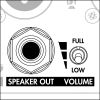 | To use the attenuator, you need to connect a cabinet to the SPEAKER OUT of the Torpedo Captor X. You will activate the attenuator with the Volume Level switch. |
You have 3 settings for the Volume Level of the cabinet:
- FULL: the attenuator is bypassed. The full power delivered by the amp is passed on to the cabinet. Also, the impedance seen by the amp is the cabinet’s. Use the amp's speaker output that matches the cabinet (for example: 16 Ohms cabinet, use the 16 Ohms output whatever the impedance of the Captor X).
- “HALFWAY” (unlabelled): the attenuator is activated. The level is dimmed by 20dB. The amp is seeing the impedance of the Torpedo Captor X. This level is considered to be very useful to keep your cabinet on stage.
- LOW: The attenuator is fully activated and the level is reduced by 38dB - the amp is seeing the impedance of the Torpedo Captor X. This level is designed to allow you to play your tube amp at home. In most situations this will fully attenuate your amplifier, but it may be the fact that some signal still comes through your cabinet.
2. Torpedo Captor X at home
2.1 Silent use
The Torpedo Captor X is a reactive load box. This allows you to play your tube amp without using a cabinet. This is ideal at home to record at any time of the day or night practice, etc. You just need to connect your amp to the SPEAKER IN of the Torpedo Captor X. You can listen to your tube amps through the headphones output, or with your monitors using the XLR DI outputs.
2.2 With a cabinet
With the attenuator, it is possible to reduce the level of your physical cabinet suitable for home playing with up to 38dB of attenuation. Connect your cabinet to the SPEAKER OUT of the Torpedo Captor X. None of the effects or cab sim within the unit (Enhancer, Reverb, Twin Tracker, EQ) can be heard through the cabinet. You need to connect the XLR DI outputs to an audio interface or a mixing desk to listen to the audio treatment of the Torpedo Captor X on monitors.
3. Torpedo Captor X on stage
3.1 Using the Dual Mono routing
With Torpedo Remote, you can set the Torpedo Captor X to send 2 different signals out of the XLR outputs. Select the DUAL MONO routing with the purple button above the Output level knob (see section 4.4 for output routings). The signal going out of the unit can have a different eq and a different reverb level in DUAL MONO routing. See section 4.4.2 for all the options. You can send one signal to the Front Of House and the other to the monitors. The Voicing knob impacts both outputs.
3.2 With a cabinet
With the attenuator, it is possible to dim the level of your physical cabinet. The halfway position is suitable for stage levels with its 20dB of attenuation. Your cabinet will be an added source to monitor your sound. Connect your cabinet to the SPEAKER OUT of the Torpedo Captor X. None of the effects or cab sim within the unit (Enhancer, Reverb, Twin Tracker, EQ) can be heard through the cabinet.
4. Torpedo Captor X in the studio
4.1 Using the "Bypass Torpedo Processing"
The DUAL MONO routing also allows you to send a dry signal of the incoming amp signal through the right output of the Torpedo Captor X. Click on the BYPASS button above the fader of the RIGHT channel. This will bypass the whole Torpedo processing of the unit. The dry amp signal will allow you to add the cabinet simulation later in your mix with the plugin Torpedo Wall of Sound.
You are able to record two different amp signals at once in your DAW: the full Torpedo cab sim signal from the LEFT XLR output of the Torpedo Captor X, and the dry amp signal from the RIGHT XLR output.
4.2 With a cabinet
Connect your favorite cabinet and mic it to have 3 different signals recorded at the same time. Use the different Volume Level settings to adjust the level of the cabinet.
5. Want more cabs?
5.1 Two notes cabinets
You can preview any cabinets that are not in your license when using Desktop Remote. This is why when you browse the cabinets in the Remote the list is way bigger than what you have in your license or in your Torpedo Captor X.
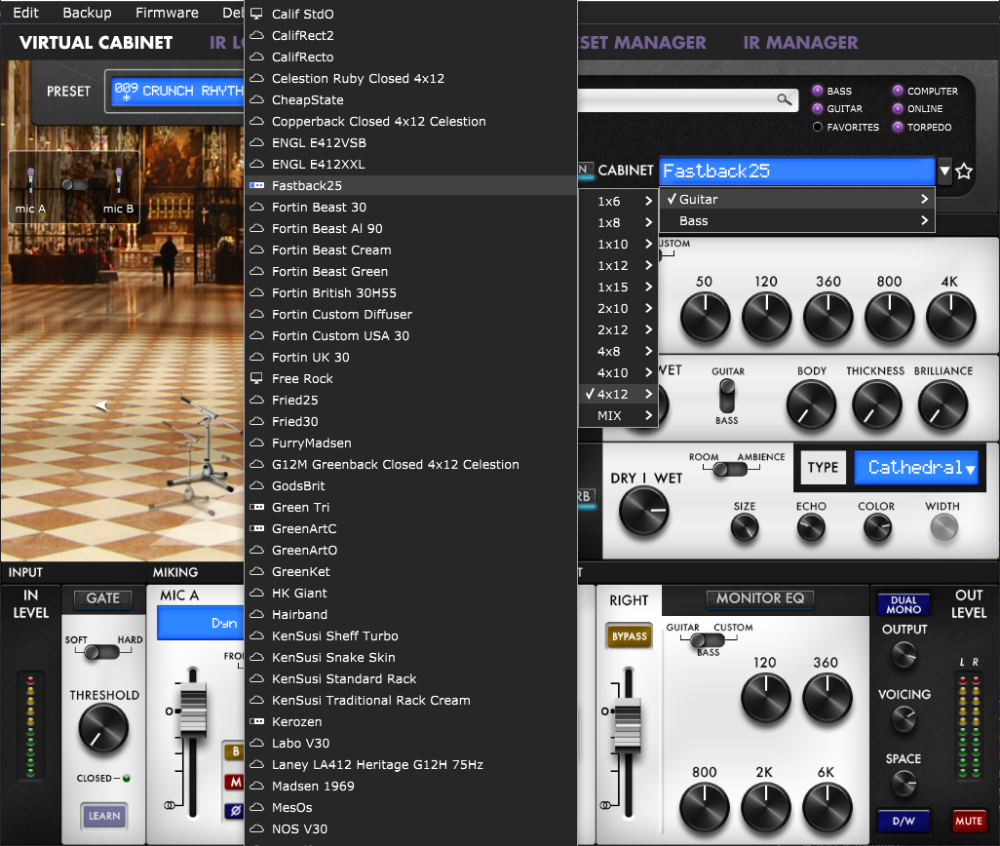 You will see 3 types of icons in front of the names of the cabinets :
You will see 3 types of icons in front of the names of the cabinets :
| | Cabinets which are on your Torpedo unit. |
| | Cabinets which are on your licence loaded in your computer |
| | Cabinets which you do not own but can preview before buying them on the Two notes Store. |
When you are previewing a cabinet that is on your computer (which means that you own it and it is in your license stored in your computer), the Remote needs to load the cabinet first so you can edit all the parameters. As you are previewing, you will only have access to one microphone for the cabinet. Audio is still going through the unit, so you can use the Captor X as you would normally.
| | This box allows you to transfer the cabinet you are previewing from your computer to your Captor X (as long as you have memory slots available in your unit). |
When you are previewing a cabinet that you do not own, random silences are inserted and you only have access to one mic to preview the cabinets.
For your security, no billing or information on the payment method is stored on the Remote.
5.2 .tur files
.tur are proprietary files created with the Two notes Audio Engineering Torpedo BlendIR software. The software is available for download from the Two notes Audio Engineering website. With Torpedo BlendIR you are able to use the Torpedo technology to capture the sound signature of your own cabinet and microphone in the deepest details.
To load a file into the Torpedo, place it in the default Impulse directory, or select the directory containing the files through Torpedo Remote (this can be done in the menu). You can then load the files into the Torpedo through the Memory Manager or directly listen to them through the main Remote window.
Please note that with .tur files you do not have access to the microphone positioning parameter.
Setup Manager
This section of Torpedo Remote sets the hardware parameters of the unit such as the audio latency, the MIDI mapping, the white LED, etc. You will also find the serial number of the unit, as well as the firmware version. You will also set the reference point for the tuner. By default, it is set at 440 hz.
1. MIDI
The Torpedo Captor X handles both preset change commands (Program Change or PC) and parameter change commands (Control Change or CC). This way, you can interact with all the parameters on the unit from any kind of standard MIDI controller, like a MIDI pedalboard or a keyboard.
- Select if the unit is to receive to Program Change and/or Control Change commands. For example, if you plan to use the preset switching (PC), the CC receive can be Off.
- Set a MIDI channel for the unit to receive. You can choose to receive all channels, which is useful when you don’t know exactly on which channel the commands are sent.
- With the MIDI monitor, check the correct reception of the commands by the Torpedo Captor X.
See section 7.1 MIDI Mapping for the tables concerning Program Change and Command Change.
2. Audio Performance
The indicated latency is the actual latency of the whole device, measured from the input to the output. Even at the highest setting, the latency is low enough not to be noticed when playing. However, latencies add up when using several digital products, which can lead to a point where it becomes noticeable. In that case, lowering this setting can prove useful.
- Latency is 1.2ms with IR Length at 20ms
- Latency is 2.2ms with IR Length at 40ms
- Latency is 3.5ms with IR Length at 100ms
- Latency is 4.8ms with IR Length at 200ms
The factory default setting of the unit is 3.5ms of latency.
Impedance selection guide
The effective impedance of the ensemble “amp + Torpedo Captor X + speaker cabinet (ie, the impedance actually seen by the amplifier) depends on the position of the VOLUME LEVEL switch:
| My situation | Volume Level Setting | Impedance seen by the amp |
| I have a speaker cabinet connected to the SPEAKER output | Volume Level on LOW and halfway position | Impedance of the Captor X |
| I have a speaker cabinet connected to the SPEAKER output | Volume Level on FULL position | Impedance of the cabinet |
It is implied throughout the manual that the amp and the Captor X have matching impedance (you are using the matching speaker output of your amp to connect to the Captor X). In that setup, when the Volume Level switch is on FULL, if your cabinet has a different impedance than the Captor X, you will have an impedance mismatch. If you want or need to mismatch the impedance of the amp and load, we recommend the following:
- Only go for small mismatches: 4 vs 8, 8 vs 16. But not 2 vs 8 or 16, 4 vs 16.
- Play your amp at low level, at least at first. Monitor the behavior of the amp, the tone coming out of it, the color of the output tubes. If anything seems wrong, stop playing. In short, follow even more carefully the Recommendation on the proper use of a load box with a tube amplifier you'll find in the user manual of your Torpedo product.
This article about Impedance mismatch outlines all the precautions to take in making this match as safe as possible.
Transistor (solid-state) amps are designed differently, and usually have a “minimum load” rating rather than expecting an exact impedance match. This means you can use any speaker or load box with an impedance equal or greater than this rating. A speaker output rated “8 ohms min” can safely be used with 8 or 16 ohms loads.
IMPORTANT NOTE: when the Volume Level switch is on FULL, the internal loadbox is disconnected as soon as you plug a cable in the SPEAKER output of the Captor X. The amplifier connected to the Captor X is no longer connected to its internal loadbox, but to whatever is connected to the other end of this cable. As a result, if you connect a cable in the SPEAKER output of the Captor X with nothing else connected to the other end, your amplifier will not be connected to a proper load.
Specifications
1. MIDI
1.1 MIDI cable
The Torpedo Captor is supplied with a MIDI 5 pin DIN type A connector to TRS jack 3.5 mm (1/8”) connector. The wiring of the cable complies with the standard set by The MIDI Manufacturers Association (MMA) for use of TRS Connectors with MIDI Devices.
The wiring is as follow:
* Tip is connected to pin N°5
* Ring is connected to pin N°4
* Sleeve is connected to pin N°2
For all information on the standard as set by the MMA, visit their website.
1.2 Program Change (PC)
Each preset on the Torpedo Captor X has a single program number. The preset 001 of the machine is triggered by a MIDI PC 1, you can address the 128 presets, with MIDI PC 1 to MIDI PC 128. This way, it is possible to randomly access the preset by sending the appropriate MIDI PC number.
1.3 Control change (CC)
The following table indicates the Control Change numbers for every parameter, as well as their range and behavior.
| < 100% 20% 10% 15% 55% > |
| Parameter | CC# | Range | Behavior |
|---|---|---|---|
| Simulation & IR Loader modes | |||
| Cab/mic | |||
| On/Off | 6 | 0-1 | 0 = Off ; 1 = On |
| Unused | 7 | 0-1 | 0 = Off ; 1 = On |
| Cab | 8 | 0-x | 0 = Cab #0 ; 1 = Cab #1… |
| File A | 9 | 0-x | 0 = File #0 ; 1 = File #1… |
| File B | 10 | 0-x | 0 = File #0 ; 1 = File #1… |
| Folder A | 11 | 0-3 | 0= User 0 ; 1= User1; 2 = User 2 ; 3 = User 3 |
| Folder B | 12 | 0-3 | 0= User 0 ; 1= User1; 2 = User 2 ; 3 = User 3 |
| Mic A | 13 | 0-7 | 0 = Mic #1 ; 1 = Mic #1… |
| Distance A | 14 | 0-127 | 0 = 0% ; 63 = 50% ; 127 = 100% |
| Center A | 15 | 0-127 | 0 = 0% ; 63 = 50% ; 127 = 100% |
| Position A | 16 | 0-1 | 0 = Back : 1 = Front |
| Level A | 35 | 0-107 | 0 = -95dB ; 95 = 0dB ; 107 = 12dB |
| Phase A | 36 | 0-1 | 0 = Normal ; 1 = Invert |
| Mute A | 37 | 0-1 | 0 = Off (no mute) ; 1 = On (mute) |
| Mic B | 38 | 0-7 | 0 = Mic #1 ; 1 = Mic #1… |
| Distance B | 39 | 0-127 | 0 = 0% ; 63 = 50% ; 127 = 100% |
| Center B | 40 | 0-127 | 0 = 0% ; 63 = 50% ; 127 = 100% |
| Position B | 41 | 0-1 | 0 = Back : 1 = Front |
| Level B | 42 | 0-107 | 0 = -95dB ; 95 = 0dB ; 107 = 12dB |
| Phase B | 43 | 0-1 | 0 = Normal ; 1 = Invert |
| Mute B | 44 | 0-1 | 0 = Off (no mute) ; 1 = On (mute) |
| Bypass A | 51 | 0-1 | 0 = Off (Mic on) ; 1 = On (Mic Bypass) |
| Bypass B | 52 | 0-1 | 0 = Off (Mic on) ; 1 = On (Mic Bypass) |
| EQ | |||
| On/Off | 17 | 0-1 | 0 = Off ; 1 = On |
| Mode | 18 | 0-2 | 0 = Guitar : 1 = Bass ; 2 = Custom |
| Gain: Low | 19 | 0-40 | 0 = -20dB ; 20 = 0dB ; 40 = 20dB |
| Gain: Low Mid | 20 | 0-40 | 0 = -20dB ; 20 = 0dB ; 40 = 20dB |
| Gain: Mid | 21 | 0-40 | 0 = -20dB ; 20 = 0dB ; 40 = 20dB |
| Gain: High Mid | 22 | 0-40 | 0 = -20dB ; 20 = 0dB ; 40 = 20dB |
| Gain: High | 23 | 0-40 | 0 = -20dB ; 20 = 0dB ; 40 = 20dB |
| Freq: Low Cut | 45 | 0-127 | Specific mapping to Hz |
| Freq: Low | 46 | 0-127 | Specific mapping to Hz |
| Freq: Low Mid | 47 | 0-127 | Specific mapping to Hz |
| Freq: Mid | 48 | 0-127 | Specific mapping to Hz |
| Freq: High Mid | 49 | 0-127 | Specific mapping to Hz |
| Freq: High | 50 | 0-127 | Specific mapping to Hz |
| Level | |||
| Preset Level | 24 | 0-107 | 0 = -95dB ; 107 = +12dB |
| Preset Level R | 86 | 0-107 | 0 = -95dB ; 107 = +12dB |
| Reverb | |||
| On/Off | 25 | 0-1 | 0 = Off ; 1 = On |
| Preset | 26 | 0-7 | 0 = Room #0 ; 1 = Room #1… |
| Dry/Wet | 27 | 0-127 | 0 = 0% ; 63 = 50% ; 127 = 100% |
| Dry/Wet R | 72 | 0-127 | 0 = 0% ; 63 = 50% ; 127 = 100% |
| Size | 53 | 0-127 | 0 = 0% ; 63 = 50% ; 127 = 100% |
| Echo | 54 | 0-127 | 0 = 0% ; 63 = 50% ; 127 = 100% |
| Color | 55 | 0-127 | 0 = 0% ; 63 = 50% ; 127 = 100% |
| Type | 56 | 0-1 | 0 = Room ; 1= Ambience |
| Width | 57 | 0-127 | 0 = 0% ; 63 = 50% ; 127 = 100% |
| Noise Gate | |||
| On/Off | 58 | 0-1 | 0 = Off ; 1 = On |
| Mode | 59 | 0-1 | Soft = Off ; Hard = On |
| Threshold | 60 | 0-80 | 0 = -80dB ; 80 = 0dB |
| Enhancer | |||
| On/Off | 61 | 0-1 | 0 = Off ; 1 = On |
| Instrument | 62 | 0-1 | 0 = Guitar ; 1 = Bass |
| Body | 63 | 0-127 | 0 = 0% ; 63 = 50% ; 127 = 100% |
| Thickness | 64 | 0-127 | 0 = 0% ; 63 = 50% ; 127 = 100% |
| Brilliance | 65 | 0-127 | 0 = 0% ; 63 = 50% ; 127 = 100% |
| Dry/Wet | 66 | 0-127 | 0 = 0% ; 63 = 50% ; 127 = 100% |
| Twin Tracker | |||
| On/Off | 67 | 0-1 | 0 = Off ; 1 = On |
| Tightness | 68 | 0-127 | 0 = 0% ; 63 = 50% ; 127 = 100% |
| Balance | 69 | 0-127 | 0 = 0% ; 63 = 50% ; 127 = 100% |
| Output | |||
| Mode | 70 | 0-2 | 0 = Stereo ; 1 = Dual Mono ; 2 = Dual Mono, R Bypass) |
| Space Pot Assign | 71 | 0-1 | Stereo: 0 = Stereo Expander ; 1 = Dry/Wet Dual Mono: 0 = Dry/Wet ; 1 = Dry/Wet L ; 2 = Dry/Wet R Dual Mono, R Bypass: 0 = Dry/Wet |
| EQ R | |||
| On/Off | 73 | 0-1 | 0 = Off ; 1 = On |
| Mode | 74 | 0-2 | 0 = Guitar : 1 = Bass ; 2 = Custom |
| Gain: Low | 75 | 0-40 | 0 = -20dB ; 20 = 0dB ; 40 = 20dB |
| Gain: Low Mid | 76 | 0-40 | 0 = -20dB ; 20 = 0dB ; 40 = 20dB |
| Gain: Mid | 77 | 0-40 | 0 = -20dB ; 20 = 0dB ; 40 = 20dB |
| Gain: High Mid | 78 | 0-40 | 0 = -20dB ; 20 = 0dB ; 40 = 20dB |
| Gain: High | 79 | 0-40 | 0 = -20dB ; 20 = 0dB ; 40 = 20dB |
| Freq: Low Cut | 80 | 0-127 | Specific mapping to Hz |
| Freq: Low | 81 | 0-127 | Specific mapping to Hz |
| Freq: Low Mid | 82 | 0-127 | Specific mapping to Hz |
| Freq: Mid | 83 | 0-127 | Specific mapping to Hz |
| Freq: High Mid | 84 | 0-127 | Specific mapping to Hz |
| Freq: High | 85 | 0-127 | Specific mapping to Hz |
| General - Preset | |||
| Mode | 34 | 0-2 | 0 or 1 = Simulation ; 2 = IR Loader |
| General | |||
| Out Level | 87 | 0-107 | 0 = -95dB ; 95 = 0dB ; 107 = 12dB |
| Mute | 88 | 0-1 | 0 = Off (no mute) ; 1 = On (mute) |
| Bypass | 89 | 0-1 | 0 = Bypass ; 1 = On |
| Preset | 90 | 0-127 | 0 = Preset #1 ; 1 = Preset #2… |
| Voicing | 91 | 0-127 | 0 = 0% ; 63 = 50% ; 127 = 100% |
| Space | 92 | 0-127 | 0 = 0% ; 63 = 50% ; 127 = 100% |
2. List of included cabinets
| Designation | Inspired by |
|---|---|
| GUITAR cabinets | |
| Angl Pro30 | Engl® 4×12 Celestion® Vintage 30 |
| Angl VintC | Engl® 4×12 |
| BdeLuxe | Fender® Blues Deluxe |
| Brit 65O | Marshall® 1965A 4×10 Celestion® G10L-35 open back |
| Brit VintC | Marshall® Slash Signature 4×12 with Celestion® V30 |
| Calif StdC | Mesa/Boogie® Rectifier® Standard 4×12 Celestion® V30 closed back |
| Eddie | Peavey® 5150 2×12 Sheffield 1200 |
| Eggbeater | Egnater® Tourmaster cabinet |
| FastBack | 4×12 cabinet with Celestion® Pre-Rola G12M Greenback |
| Forest | Elmwood® 2×12 cabinet with Celestion® V30 |
| Free Rock2 | VHT® Deliverance 2×12 Eminence® P50E |
| GreenArtC | Marshall® 4×12 for JMP Amplifier |
| GreenTri | Hughes&Kettner® Triamp 4×12 with Celestion® Greenback |
| Jazz120 | Vintage Roland® JC120 2×12” |
| JubilGreen | Marshall® 2556AV 2×12 Celestion® Greenback |
| Kerozen | Diezel® 4×12” Celestion® G12K-100 |
| RackHeroJP | Custom Audio Amplifier 2×12 with Celestion® G12T-75 |
| Rand NB412 | Randall® Signature Series 4×12 angled with Celestion® Greenback |
| SilverJen | Fender® Twin Reverb® 2×12 with Jensen® speakers |
| StrongBack | VHT® Fat Bottom series cabinet P50E speaker |
| Tanger 30C | PPC112HP© 1×12 Orange® with Celestion® Vintage 30 |
| The One | Brunetti® Neo1512 1×15” + 1×12” |
| Vibro V30 | Vintage 1961 Fender® Vibrolux® 1×12 Celestion® V30 |
| Voice 30 | Original Vox® AC30 JMI 2×12 Celestion® “Silver Bell” |
| Watt FanC | Hiwatt® 2×12 Fane closed back |
| XTCab | Bogner® 4×12” Celestion® V30 |
| BASS cabinets | |
| AluXL | Hartke® XL 4×10” |
| Bull Neo2 | 2×10“ cabinet |
| Fridge9 | Ampeg® 9×10” |
| Heaven Top | David Eden® 4×10 Markbass® 2×10 |
| Marco | Markbass® 2×10 |
| New York | Markbass® 4×6” |
3. List of Microphones
Each cabinet in the Two notes library comes with a choice of 8 perfectly matched microphones. The selection of microphones depends on the type and model of the cabinet and each had been carefully selected for maximum response and tonal quality.
Don’t be afraid to try the bass mics on your guitar tone and guitar mics on your bass tones!
| Designation | Inspired by |
|---|---|
| Dynamic 57 | Dynamic microphone Shure® SM57 |
| Dynamic 421 | Dynamic microphone Sennheiser® MD421 |
| Knightfall | Condenser microphone Blue® Dragonfly |
| Condenser 87 | Condenser microphone Neumann® U87 |
| Ribbon160 | Ribbon microphone Beyerdynamic® M160N |
| Ribbon121 | Ribbon microphone Royer® R121 |
| Bass 20 | Dynamic microphone Electrovoice® RE20 |
| Bass 52 | Dynamic microphone Shure® Beta52 |
4. Block diagram
5. Technical Data
| Designation | Characteristics |
|---|---|
| SPEAKER IN | 6.35mm (1/4 in) Jack unbalanced (TS, Tip/Sleeve) IN LEVEL switch affects input sensitivity High: 0 dB Low: -15 dB |
| SPEAKER OUT | 6.35mm (1/4 in) Jack unbalanced (TS) |
| LEFT/RIGHT OUTPUTS | XLR Balanced Maximum output level: 15 dBu. Impedance: 600 Ohms |
| PHONES | 6.35mm (1/4 in) Jack balanced TRS, Tip/Ring/sleeve) |
| MIDI Input | 1/8″ jack balanced TRS. Jack to MIDI cable adapter supplied. |
| USB | Micro USB B port. Micro USB-B to USB-A cable supplied. |
| ADC/DAC | Sampling frequency: 96 kHz Resolution: 24 bits |
| Frequency response | 30 Hz - 19 kHz |
| Min Latency | 2.2 ms (LINE IN to LINE OUT) |
| THD+N ratio | 0.03% (IN LEVEL 0dB, sine wave 1kHz 4dBu) |
| Signal to Noise Ratio | 95dB |
| Power supply | 100-240v AC / Output: 12V DC, 1A supplied. |
| Dimensions | 128 (w) x 175 (d) x 64 (h) mm Weight: 1.3 kg |
Technical support
Should you encounter a problem with your product or need help regarding any technical aspects, please note that Two notes Audio Engineering has developed on-line services to provide you with fast and efficient technical support, the Two notes Help Desk.
Don't hesitate to browse the Knowledgebase, which contains all sorts of useful information, or submit a ticket if you have any question or need assistance with a Two notes product.
1. Two notes Website
On the Two notes Audio Engineering website, you will find:
- news about the company and the products (news on the homepage),
- comprehensive information about the Torpedo Captor X and its many applications (FAQ),
- firmware and software updates to download (products/Torpedo Captor X/downloads),
- access to the Two notes Store where you can buy new cabinets,
- the Torpedo BlendIR software (products/Torpedo Captor X/downloads),
- an official forum where you can share tips and advice with other Torpedo users (forum).
The Two notes Team often visits specialized forums to help out users.
Social Media
Please follow us on Facebook, Instagram (@twonotesaudio) and Twitter (@twonotesaudio) for the latest updates and product news (we release new cabinets all the time). We love it when people share photos of their Two notes loaded rigs and we often share them - make sure you use the #mytwonotes hashtag to get our attention!
We also have a very useful community group on Facebook where we (and lots of our customers) like to hang out, procrastinate, share ideas and generally give each other GAS.
Please subscribe to our newsletter to get early warning of new products and releases before the general public!
2. E-mail
We do not offer technical support via e-mail. Please contact us via the Help Desk at the address above.
